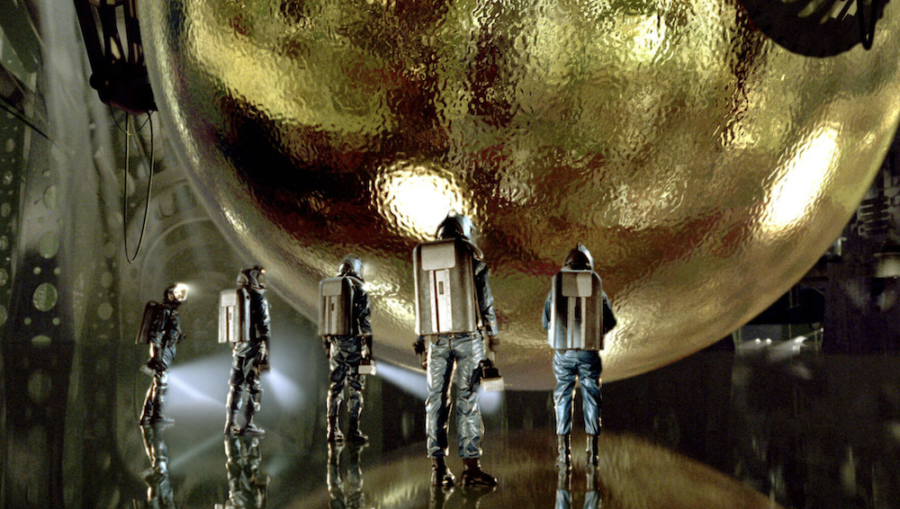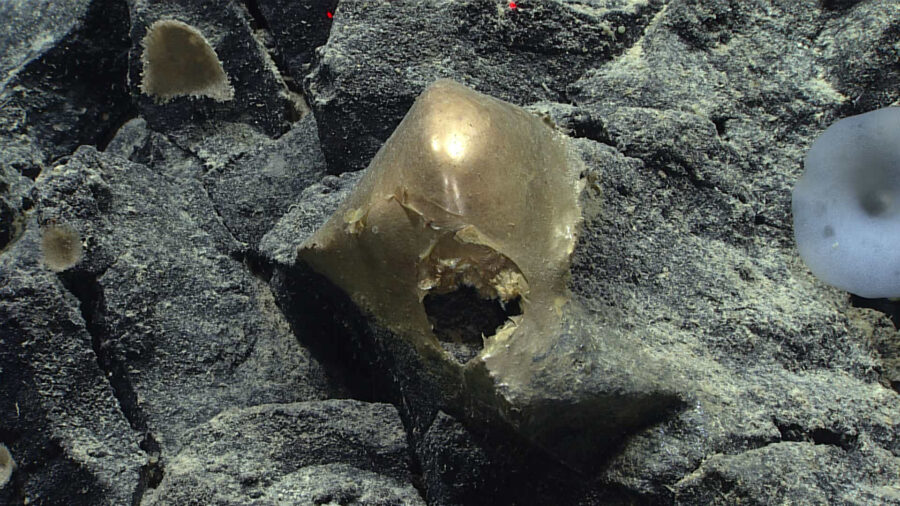Golden Orb Found At Ocean Bottom, Michael Crichton’s Sphere Comes True

It would seem an unwritten law of physics that life must, eventually, imitate art. No example illustrates this maxim better than the recent find off the coast of Alaska. A bizarre, golden orb was discovered by researchers from NOAA Ocean Exploration. Of course, the discovery invites unavoidable comparisons to Michael Crichton’s famous, terrifying novel, Sphere.
The strange object challenging—and expanding—our understanding of the ocean’s mysteries was nestled about 3,300 meters (two miles) beneath the ocean’s surface, in an area utterly untouched by sunlight. A remotely operated underwater vehicle encountered the orb, which tightly adhered to a rock encircled by white sponges.
Initial theories ran the gambit: an egg casing of an unidentified species, a dead sponge—while some even theorized it’s a type of coral.

The object measures nearly 10 centimeters (4 inches) across and features a peculiar hole on one side. Excitingly, the researchers streamed their discovery of the orb live, further contributing to the waves of speculation and intrigue surrounding it.
The golden orb’s unusual appearance baffled scientists—the perfect beginning for a horror movie, as any fan of the film adaptation of Crichton’s novel will tell you. Initial theories ran the gambit: an egg casing of an unidentified species, a dead sponge—while some even theorized it’s a type of coral.
During the live stream, one researcher opined that a large hole in the object implied some…creature…either tried to enter or exit the orb.
The non-zero chance that the sphere served as an egg from which some creature crawled out–in a zone of the ocean literally devoid of light–heightens the creepy vibe.
However, the object inspires fascination as much as fear, both of which are often hard to separate. For example, in a scene ripped from a sci-fi-horror screenplay (perhaps an unwritten title in the Alien franchise), a researcher watching the livestream cautioned against poking the golden orb.
After all, the scientist pointed out, “something” could emerge from the opening. Indeed, the non-zero chance that the sphere served as an egg from which some creature crawled out–in a zone of the ocean literally devoid of light–heightens the creepy vibe.
In fact, Kerry Howell, a deep-sea ecologist from the University of Plymouth, suggested that the orb’s fleshy texture lacking easily discernable anatomy means it’s likely an egg.
Assuming the sphere is from this planet and not a terrifying alien world many galaxies away, DNA tests should resolve the biological origin of the orb down the line.
The sphere’s large size also interests experts.
While fish eggs are usually small, the golden orb is anything but—hinting at a larger, as-of-yet-unknown entity.
Scientists employed a robotic arm to prod the orb and discovered it was quite soft. Subsequently, they carefully gathered samples via suction for further analysis. Assuming the sphere is from this planet and not a terrifying alien world many galaxies away, DNA tests should resolve the biological origin of the orb down the line.
Another aspect of the “egg” puzzling scientists is its isolation, considered as extortionary as its size.
Oviparous animals (creatures laying eggs that barely develop embryonically) usually lay eggs in groups. The solitary nature of the golden orb thusly implies an odd reproductive process—perhaps one unique to deep-sea life.
In any case, the discovery of the orb testifies to the deep sea’s mysterious, if not scary, wonders. It’s also a shining example of the utility and marvel of remotely operated vehicles. Through such genuinely futuristic technology, scientists can slowly reveal the secrets of often extremely hostile, otherwise unreachable environments.
Source: NOAA Ocean Exploration












